Vaccination and Autism: A Public Health Research Report
VerifiedAdded on 2019/10/31
|14
|3050
|132
Report
AI Summary
This report addresses the ongoing public health concern regarding the potential link between vaccination, particularly the MMR vaccine, and autism spectrum disorder (ASD). It begins by outlining the research question and the sources of evidence used, including peer-reviewed journals, government health websites, and databases. The report then presents a structured analysis of several key studies, including meta-analyses, systematic reviews, and experimental quantitative studies. These studies investigate the relationship between vaccination and autism, often refuting the link and highlighting the safety of vaccines. The report also examines the impact of health scares on parental information needs and preferred information sources, as well as the role of media and misinformation in shaping public perception. The findings consistently demonstrate a lack of correlation between vaccination and autism, while also acknowledging the importance of addressing parental concerns and building trust in healthcare systems. The report emphasizes the need for clear communication, evidence-based information, and strategies to address vaccine hesitancy, ultimately promoting informed decision-making and public health.
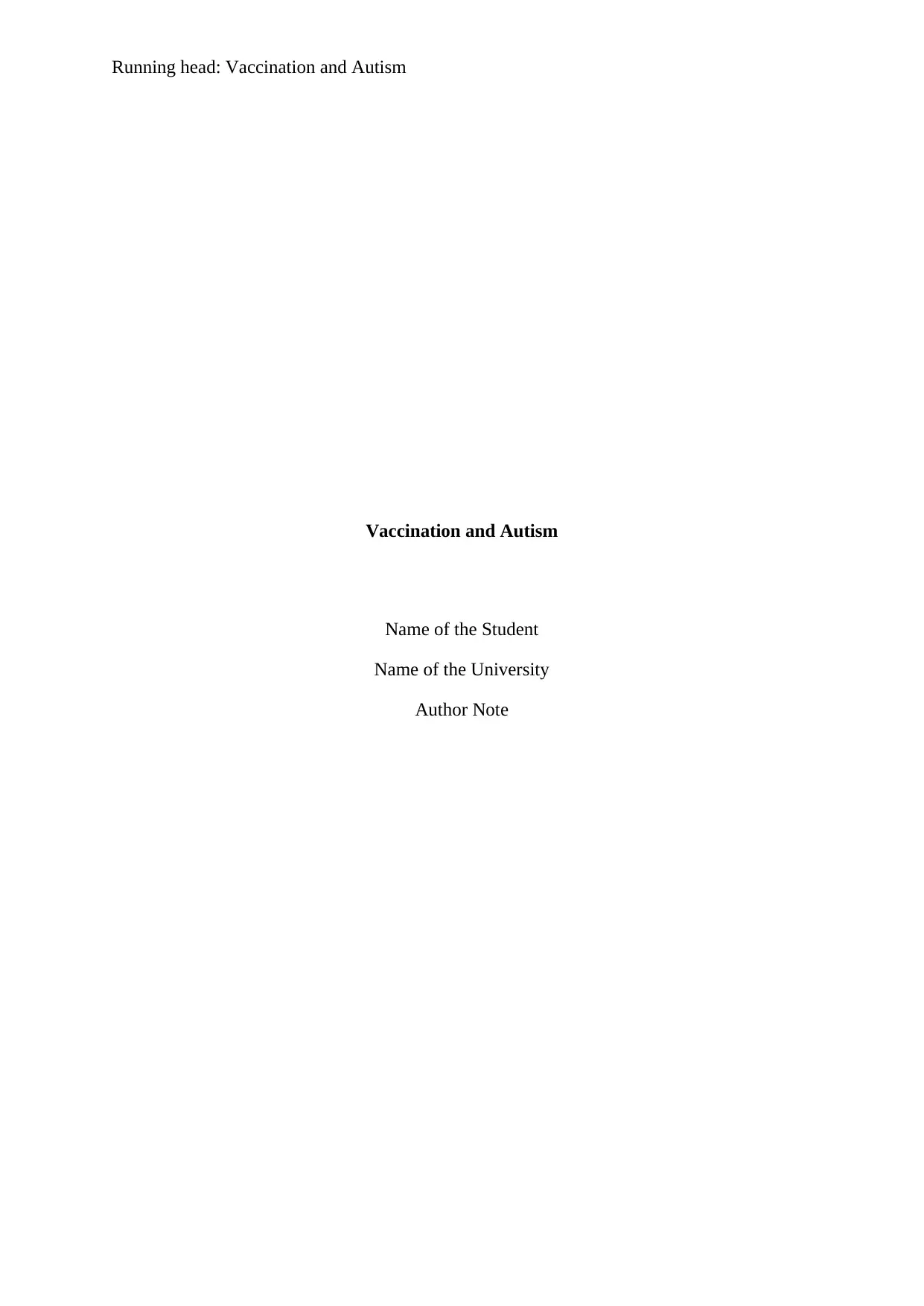
Running head: Vaccination and Autism
Vaccination and Autism
Name of the Student
Name of the University
Author Note
Vaccination and Autism
Name of the Student
Name of the University
Author Note
Paraphrase This Document
Need a fresh take? Get an instant paraphrase of this document with our AI Paraphraser
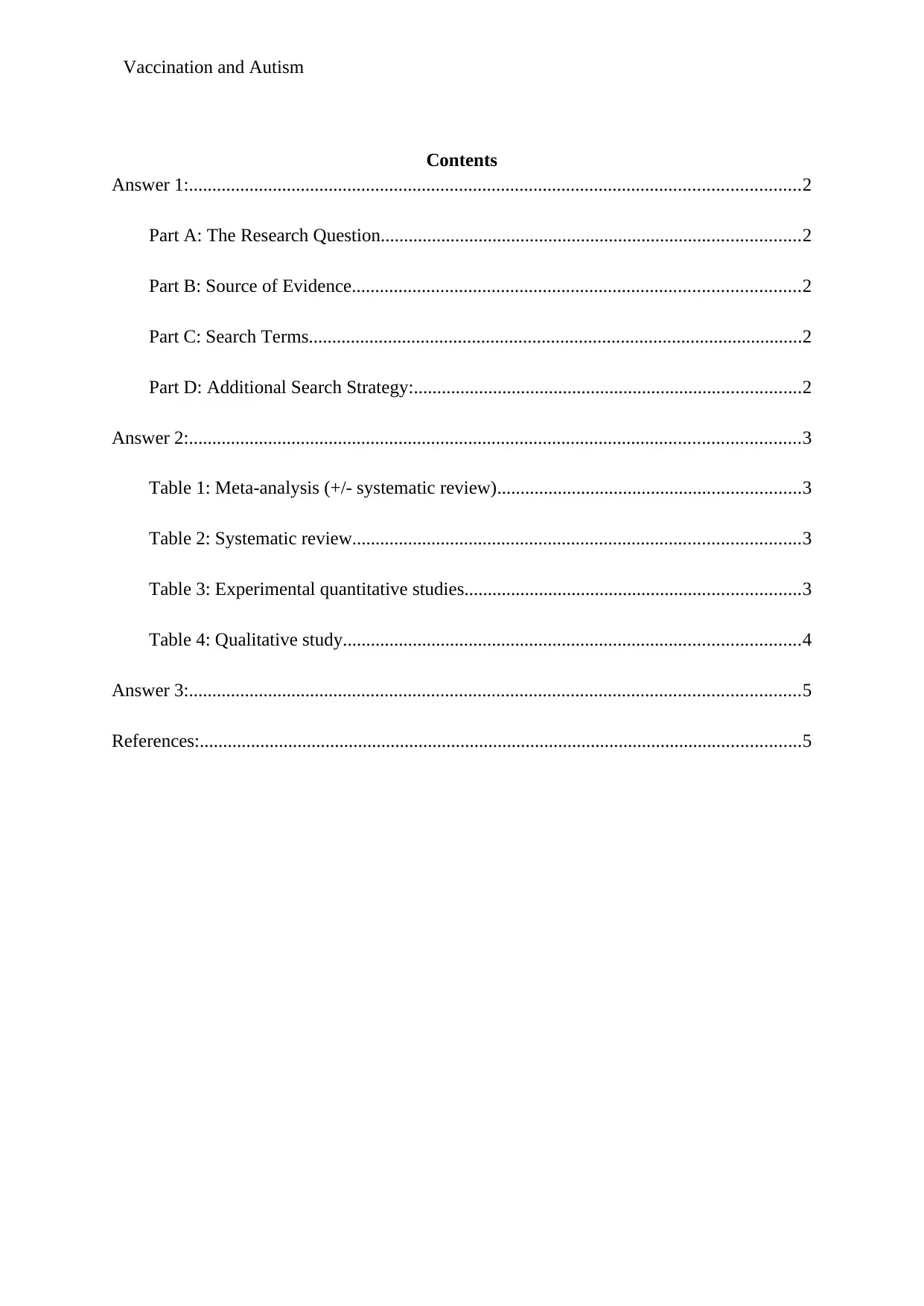
Vaccination and Autism
Contents
Answer 1:...................................................................................................................................2
Part A: The Research Question..........................................................................................2
Part B: Source of Evidence................................................................................................2
Part C: Search Terms..........................................................................................................2
Part D: Additional Search Strategy:...................................................................................2
Answer 2:...................................................................................................................................3
Table 1: Meta-analysis (+/- systematic review).................................................................3
Table 2: Systematic review................................................................................................3
Table 3: Experimental quantitative studies........................................................................3
Table 4: Qualitative study..................................................................................................4
Answer 3:...................................................................................................................................5
References:.................................................................................................................................5
Contents
Answer 1:...................................................................................................................................2
Part A: The Research Question..........................................................................................2
Part B: Source of Evidence................................................................................................2
Part C: Search Terms..........................................................................................................2
Part D: Additional Search Strategy:...................................................................................2
Answer 2:...................................................................................................................................3
Table 1: Meta-analysis (+/- systematic review).................................................................3
Table 2: Systematic review................................................................................................3
Table 3: Experimental quantitative studies........................................................................3
Table 4: Qualitative study..................................................................................................4
Answer 3:...................................................................................................................................5
References:.................................................................................................................................5
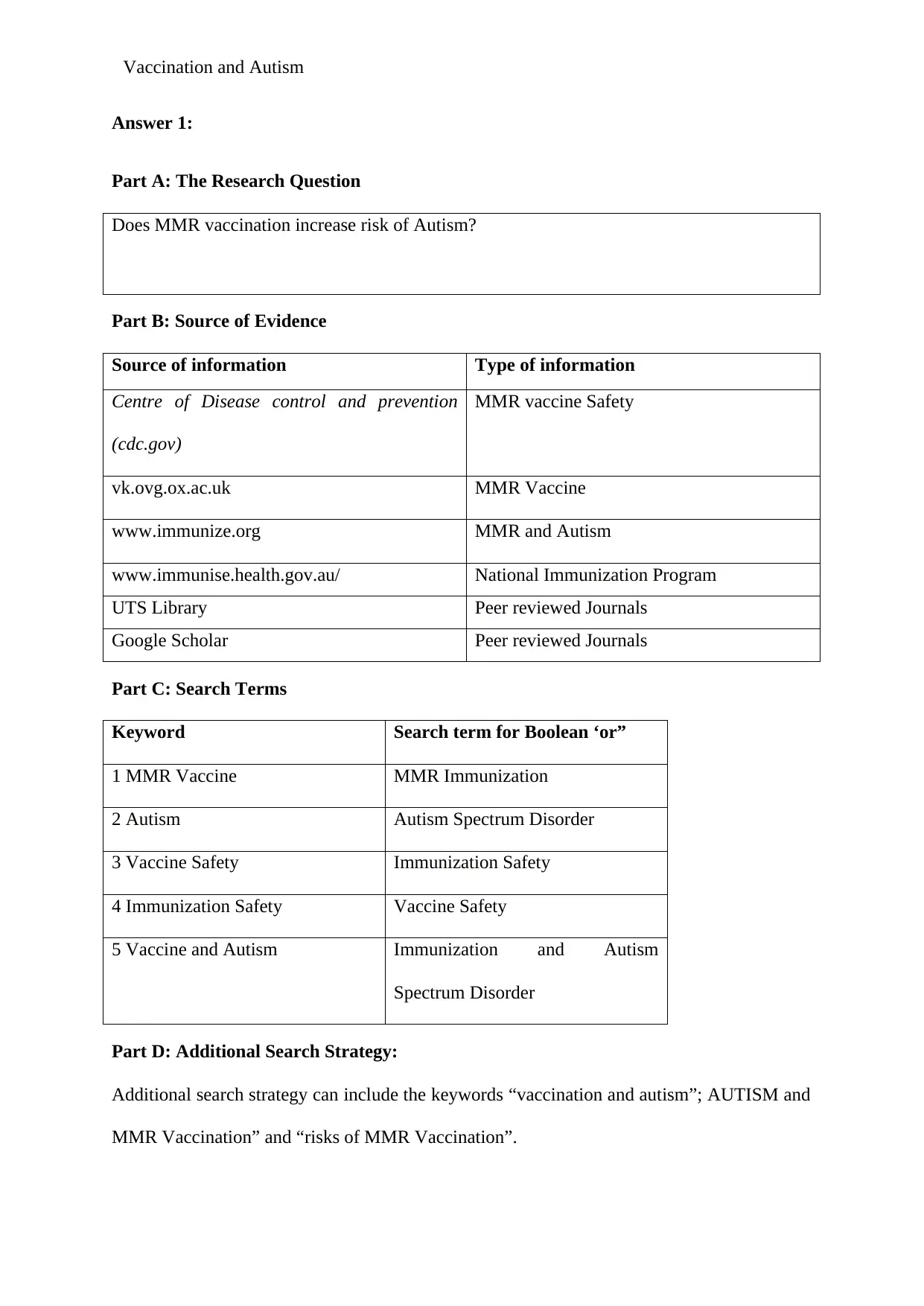
Vaccination and Autism
Answer 1:
Part A: The Research Question
Does MMR vaccination increase risk of Autism?
Part B: Source of Evidence
Source of information Type of information
Centre of Disease control and prevention
(cdc.gov)
MMR vaccine Safety
vk.ovg.ox.ac.uk MMR Vaccine
www.immunize.org MMR and Autism
www.immunise.health.gov.au/ National Immunization Program
UTS Library Peer reviewed Journals
Google Scholar Peer reviewed Journals
Part C: Search Terms
Keyword Search term for Boolean ‘or”
1 MMR Vaccine MMR Immunization
2 Autism Autism Spectrum Disorder
3 Vaccine Safety Immunization Safety
4 Immunization Safety Vaccine Safety
5 Vaccine and Autism Immunization and Autism
Spectrum Disorder
Part D: Additional Search Strategy:
Additional search strategy can include the keywords “vaccination and autism”; AUTISM and
MMR Vaccination” and “risks of MMR Vaccination”.
Answer 1:
Part A: The Research Question
Does MMR vaccination increase risk of Autism?
Part B: Source of Evidence
Source of information Type of information
Centre of Disease control and prevention
(cdc.gov)
MMR vaccine Safety
vk.ovg.ox.ac.uk MMR Vaccine
www.immunize.org MMR and Autism
www.immunise.health.gov.au/ National Immunization Program
UTS Library Peer reviewed Journals
Google Scholar Peer reviewed Journals
Part C: Search Terms
Keyword Search term for Boolean ‘or”
1 MMR Vaccine MMR Immunization
2 Autism Autism Spectrum Disorder
3 Vaccine Safety Immunization Safety
4 Immunization Safety Vaccine Safety
5 Vaccine and Autism Immunization and Autism
Spectrum Disorder
Part D: Additional Search Strategy:
Additional search strategy can include the keywords “vaccination and autism”; AUTISM and
MMR Vaccination” and “risks of MMR Vaccination”.
⊘ This is a preview!⊘
Do you want full access?
Subscribe today to unlock all pages.

Trusted by 1+ million students worldwide
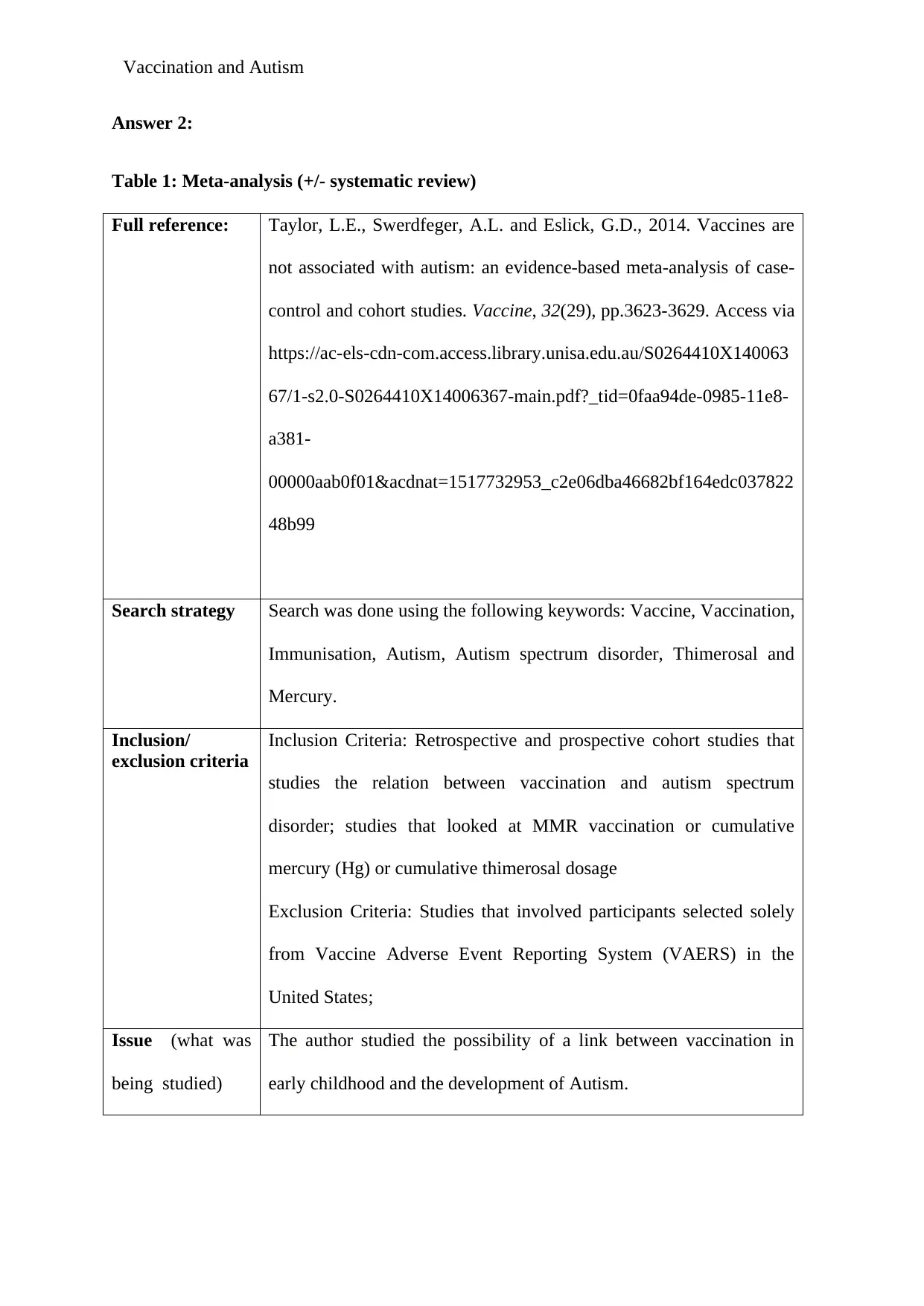
Vaccination and Autism
Answer 2:
Table 1: Meta-analysis (+/- systematic review)
Full reference: Taylor, L.E., Swerdfeger, A.L. and Eslick, G.D., 2014. Vaccines are
not associated with autism: an evidence-based meta-analysis of case-
control and cohort studies. Vaccine, 32(29), pp.3623-3629. Access via
https://ac-els-cdn-com.access.library.unisa.edu.au/S0264410X140063
67/1-s2.0-S0264410X14006367-main.pdf?_tid=0faa94de-0985-11e8-
a381-
00000aab0f01&acdnat=1517732953_c2e06dba46682bf164edc037822
48b99
Search strategy Search was done using the following keywords: Vaccine, Vaccination,
Immunisation, Autism, Autism spectrum disorder, Thimerosal and
Mercury.
Inclusion/
exclusion criteria
Inclusion Criteria: Retrospective and prospective cohort studies that
studies the relation between vaccination and autism spectrum
disorder; studies that looked at MMR vaccination or cumulative
mercury (Hg) or cumulative thimerosal dosage
Exclusion Criteria: Studies that involved participants selected solely
from Vaccine Adverse Event Reporting System (VAERS) in the
United States;
Issue (what was
being studied)
The author studied the possibility of a link between vaccination in
early childhood and the development of Autism.
Answer 2:
Table 1: Meta-analysis (+/- systematic review)
Full reference: Taylor, L.E., Swerdfeger, A.L. and Eslick, G.D., 2014. Vaccines are
not associated with autism: an evidence-based meta-analysis of case-
control and cohort studies. Vaccine, 32(29), pp.3623-3629. Access via
https://ac-els-cdn-com.access.library.unisa.edu.au/S0264410X140063
67/1-s2.0-S0264410X14006367-main.pdf?_tid=0faa94de-0985-11e8-
a381-
00000aab0f01&acdnat=1517732953_c2e06dba46682bf164edc037822
48b99
Search strategy Search was done using the following keywords: Vaccine, Vaccination,
Immunisation, Autism, Autism spectrum disorder, Thimerosal and
Mercury.
Inclusion/
exclusion criteria
Inclusion Criteria: Retrospective and prospective cohort studies that
studies the relation between vaccination and autism spectrum
disorder; studies that looked at MMR vaccination or cumulative
mercury (Hg) or cumulative thimerosal dosage
Exclusion Criteria: Studies that involved participants selected solely
from Vaccine Adverse Event Reporting System (VAERS) in the
United States;
Issue (what was
being studied)
The author studied the possibility of a link between vaccination in
early childhood and the development of Autism.
Paraphrase This Document
Need a fresh take? Get an instant paraphrase of this document with our AI Paraphraser

Vaccination and Autism
Context (study
setting)
The authors analysed scientific literature on the topic through
Systematic Reviews and Meta Analysis (PRISMA) to summarize
available evidence from case control and cohort studies on the topic.
Outcome (main
findings)
The cohort data showed no relation between vaccination and
autism.
No relation between Autism and MMR vaccination was found
No relation between Autism and thimerosal or Mercury doses
Components of MMR, mercury or themerosal are not related
to the development of ASD.
Table 2: Systematic review
Full reference Jefferson, T., Price, D., Demicheli, V., Bianco, E. and European
Research Program for Improved Vaccine Safety Surveillance
(EUSAFEVAC) Project, 2003. Unintended events following
immunization with MMR: a systematic review. Vaccine, 21(25-26),
pp.3954-3960. Access via ScienceDirect Journals (Available from
1995 volume: 13)
Context (study
setting)
The authors analysed scientific literature on the topic through
Systematic Reviews and Meta Analysis (PRISMA) to summarize
available evidence from case control and cohort studies on the topic.
Outcome (main
findings)
The cohort data showed no relation between vaccination and
autism.
No relation between Autism and MMR vaccination was found
No relation between Autism and thimerosal or Mercury doses
Components of MMR, mercury or themerosal are not related
to the development of ASD.
Table 2: Systematic review
Full reference Jefferson, T., Price, D., Demicheli, V., Bianco, E. and European
Research Program for Improved Vaccine Safety Surveillance
(EUSAFEVAC) Project, 2003. Unintended events following
immunization with MMR: a systematic review. Vaccine, 21(25-26),
pp.3954-3960. Access via ScienceDirect Journals (Available from
1995 volume: 13)
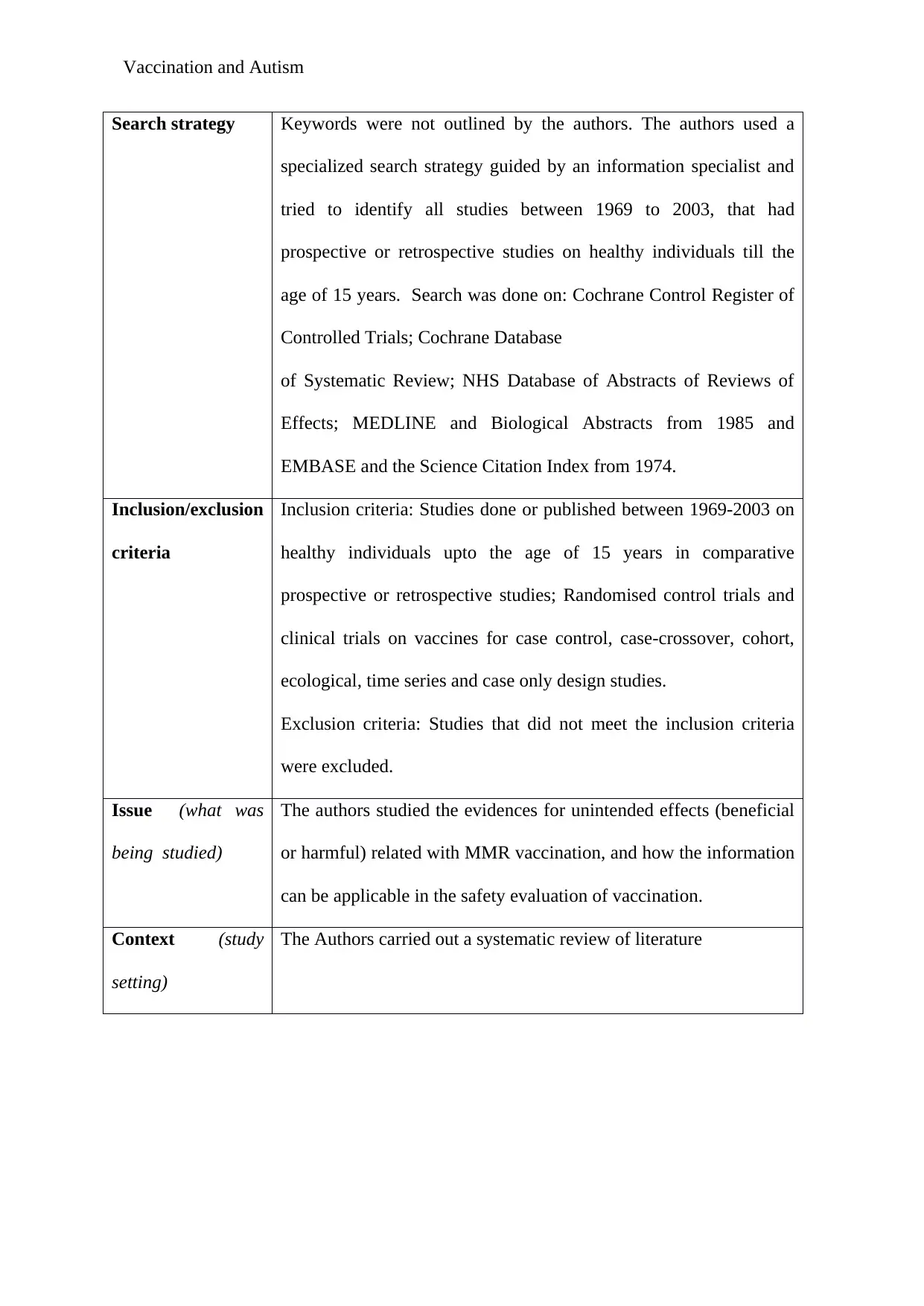
Vaccination and Autism
Search strategy Keywords were not outlined by the authors. The authors used a
specialized search strategy guided by an information specialist and
tried to identify all studies between 1969 to 2003, that had
prospective or retrospective studies on healthy individuals till the
age of 15 years. Search was done on: Cochrane Control Register of
Controlled Trials; Cochrane Database
of Systematic Review; NHS Database of Abstracts of Reviews of
Effects; MEDLINE and Biological Abstracts from 1985 and
EMBASE and the Science Citation Index from 1974.
Inclusion/exclusion
criteria
Inclusion criteria: Studies done or published between 1969-2003 on
healthy individuals upto the age of 15 years in comparative
prospective or retrospective studies; Randomised control trials and
clinical trials on vaccines for case control, case-crossover, cohort,
ecological, time series and case only design studies.
Exclusion criteria: Studies that did not meet the inclusion criteria
were excluded.
Issue (what was
being studied)
The authors studied the evidences for unintended effects (beneficial
or harmful) related with MMR vaccination, and how the information
can be applicable in the safety evaluation of vaccination.
Context (study
setting)
The Authors carried out a systematic review of literature
Search strategy Keywords were not outlined by the authors. The authors used a
specialized search strategy guided by an information specialist and
tried to identify all studies between 1969 to 2003, that had
prospective or retrospective studies on healthy individuals till the
age of 15 years. Search was done on: Cochrane Control Register of
Controlled Trials; Cochrane Database
of Systematic Review; NHS Database of Abstracts of Reviews of
Effects; MEDLINE and Biological Abstracts from 1985 and
EMBASE and the Science Citation Index from 1974.
Inclusion/exclusion
criteria
Inclusion criteria: Studies done or published between 1969-2003 on
healthy individuals upto the age of 15 years in comparative
prospective or retrospective studies; Randomised control trials and
clinical trials on vaccines for case control, case-crossover, cohort,
ecological, time series and case only design studies.
Exclusion criteria: Studies that did not meet the inclusion criteria
were excluded.
Issue (what was
being studied)
The authors studied the evidences for unintended effects (beneficial
or harmful) related with MMR vaccination, and how the information
can be applicable in the safety evaluation of vaccination.
Context (study
setting)
The Authors carried out a systematic review of literature
⊘ This is a preview!⊘
Do you want full access?
Subscribe today to unlock all pages.

Trusted by 1+ million students worldwide

Vaccination and Autism
Outcome (main
findings)
MMR vaccination was found to be related to different types of
outcomes:
Lower incidence of upper respiratory tract iunfection
Higher risk of irritability
Possible association with benign thrombocytopenic purpura
(TP), parotitis, joint and limb complaints and aseptic
meningitis
Relation with Crohn’s disease, Autism and Ulcerative colitis
is unlikely
Adverse effect of MMR vaccination cannot be separated
from its role in the prevention of target diseases.
Table 3: Experimental quantitative studies
Full reference: Prymula, R., Bergsaker, M.R., Esposito, S., Gothefors, L., Man,
S., Snegova, N., Štefkovičova, M., Usonis, V., Wysocki, J.,
Douha, M. and Vassilev, V., 2014. Protection against varicella
with two doses of combined measles-mumps-rubella-varicella
vaccine versus one dose of monovalent varicella vaccine: a
multicentre, observer-blind, randomised, controlled trial. The
Lancet, 383(9925), pp.1313-1324. Full text available via Elsevier
ScienceDirect (Available from 07/01/1995 volume: 345 issue:
8941)
Outcome (main
findings)
MMR vaccination was found to be related to different types of
outcomes:
Lower incidence of upper respiratory tract iunfection
Higher risk of irritability
Possible association with benign thrombocytopenic purpura
(TP), parotitis, joint and limb complaints and aseptic
meningitis
Relation with Crohn’s disease, Autism and Ulcerative colitis
is unlikely
Adverse effect of MMR vaccination cannot be separated
from its role in the prevention of target diseases.
Table 3: Experimental quantitative studies
Full reference: Prymula, R., Bergsaker, M.R., Esposito, S., Gothefors, L., Man,
S., Snegova, N., Štefkovičova, M., Usonis, V., Wysocki, J.,
Douha, M. and Vassilev, V., 2014. Protection against varicella
with two doses of combined measles-mumps-rubella-varicella
vaccine versus one dose of monovalent varicella vaccine: a
multicentre, observer-blind, randomised, controlled trial. The
Lancet, 383(9925), pp.1313-1324. Full text available via Elsevier
ScienceDirect (Available from 07/01/1995 volume: 345 issue:
8941)
Paraphrase This Document
Need a fresh take? Get an instant paraphrase of this document with our AI Paraphraser

Vaccination and Autism
Study Design (e.g.:
cohort, RCT,)
The authors performed randomised controlled trials on healthy
children between 12 to 22 months.
Population (how
many participants,
age, gender, disease,
etc)
Number of participants: 5803
Nationalities: Czech Republic, Greece, Italy, Lithuania, Norway,
Poland, Romania, Russia, Slovakia and Sweden
Age: 12-22 months
Gender: Both male and Female
Disease: None
Intervention (what
was being
implemented)
Two doses of MMRV (MMRV group) or
One dose of MMR and two doses of monovalent varricella
(MMR+V group)
Two doses of MMR (MMR group- control)
Comparison (was the
intervention being
compared to another
strategy, e.g.
placebo?)
The trial was randomised in three groups in the ratio of 3:3:1,
where the control group was included in the ratio of 1. This
control group (MMR) was then compared with the other two
groups studied: MMRV and MMR+V.
Outcome (main
findings)
Optimum protection from all types of varicella disease can be
ensured with a two dose varicella vaccine on a short course.
Efficacy of one dose vaccine was estimated to be 88.8 to
94.4%
Efficacy of two dose vaccine was estimated to be 98.3%
Study Design (e.g.:
cohort, RCT,)
The authors performed randomised controlled trials on healthy
children between 12 to 22 months.
Population (how
many participants,
age, gender, disease,
etc)
Number of participants: 5803
Nationalities: Czech Republic, Greece, Italy, Lithuania, Norway,
Poland, Romania, Russia, Slovakia and Sweden
Age: 12-22 months
Gender: Both male and Female
Disease: None
Intervention (what
was being
implemented)
Two doses of MMRV (MMRV group) or
One dose of MMR and two doses of monovalent varricella
(MMR+V group)
Two doses of MMR (MMR group- control)
Comparison (was the
intervention being
compared to another
strategy, e.g.
placebo?)
The trial was randomised in three groups in the ratio of 3:3:1,
where the control group was included in the ratio of 1. This
control group (MMR) was then compared with the other two
groups studied: MMRV and MMR+V.
Outcome (main
findings)
Optimum protection from all types of varicella disease can be
ensured with a two dose varicella vaccine on a short course.
Efficacy of one dose vaccine was estimated to be 88.8 to
94.4%
Efficacy of two dose vaccine was estimated to be 98.3%
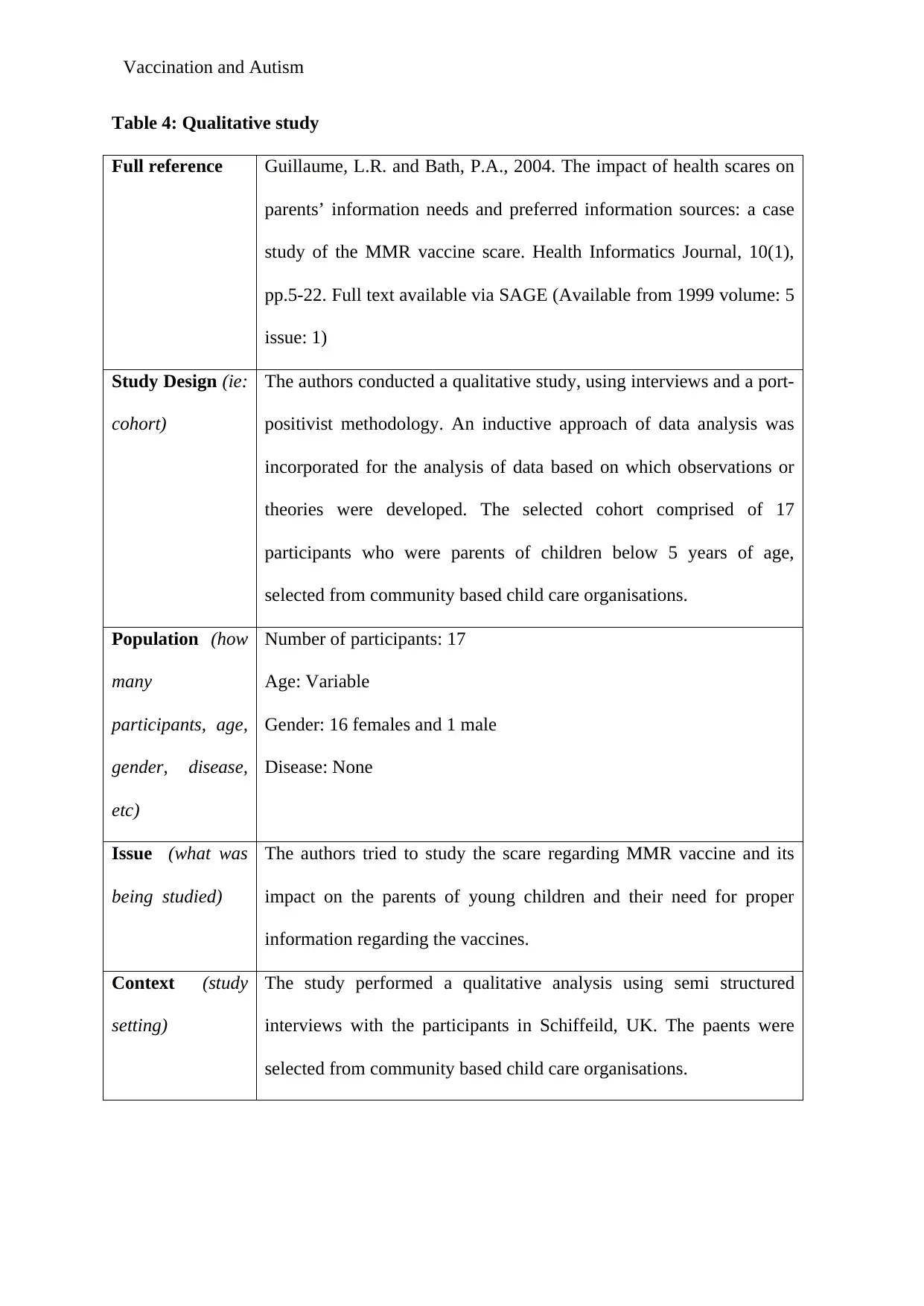
Vaccination and Autism
Table 4: Qualitative study
Full reference Guillaume, L.R. and Bath, P.A., 2004. The impact of health scares on
parents’ information needs and preferred information sources: a case
study of the MMR vaccine scare. Health Informatics Journal, 10(1),
pp.5-22. Full text available via SAGE (Available from 1999 volume: 5
issue: 1)
Study Design (ie:
cohort)
The authors conducted a qualitative study, using interviews and a port-
positivist methodology. An inductive approach of data analysis was
incorporated for the analysis of data based on which observations or
theories were developed. The selected cohort comprised of 17
participants who were parents of children below 5 years of age,
selected from community based child care organisations.
Population (how
many
participants, age,
gender, disease,
etc)
Number of participants: 17
Age: Variable
Gender: 16 females and 1 male
Disease: None
Issue (what was
being studied)
The authors tried to study the scare regarding MMR vaccine and its
impact on the parents of young children and their need for proper
information regarding the vaccines.
Context (study
setting)
The study performed a qualitative analysis using semi structured
interviews with the participants in Schiffeild, UK. The paents were
selected from community based child care organisations.
Table 4: Qualitative study
Full reference Guillaume, L.R. and Bath, P.A., 2004. The impact of health scares on
parents’ information needs and preferred information sources: a case
study of the MMR vaccine scare. Health Informatics Journal, 10(1),
pp.5-22. Full text available via SAGE (Available from 1999 volume: 5
issue: 1)
Study Design (ie:
cohort)
The authors conducted a qualitative study, using interviews and a port-
positivist methodology. An inductive approach of data analysis was
incorporated for the analysis of data based on which observations or
theories were developed. The selected cohort comprised of 17
participants who were parents of children below 5 years of age,
selected from community based child care organisations.
Population (how
many
participants, age,
gender, disease,
etc)
Number of participants: 17
Age: Variable
Gender: 16 females and 1 male
Disease: None
Issue (what was
being studied)
The authors tried to study the scare regarding MMR vaccine and its
impact on the parents of young children and their need for proper
information regarding the vaccines.
Context (study
setting)
The study performed a qualitative analysis using semi structured
interviews with the participants in Schiffeild, UK. The paents were
selected from community based child care organisations.
⊘ This is a preview!⊘
Do you want full access?
Subscribe today to unlock all pages.

Trusted by 1+ million students worldwide
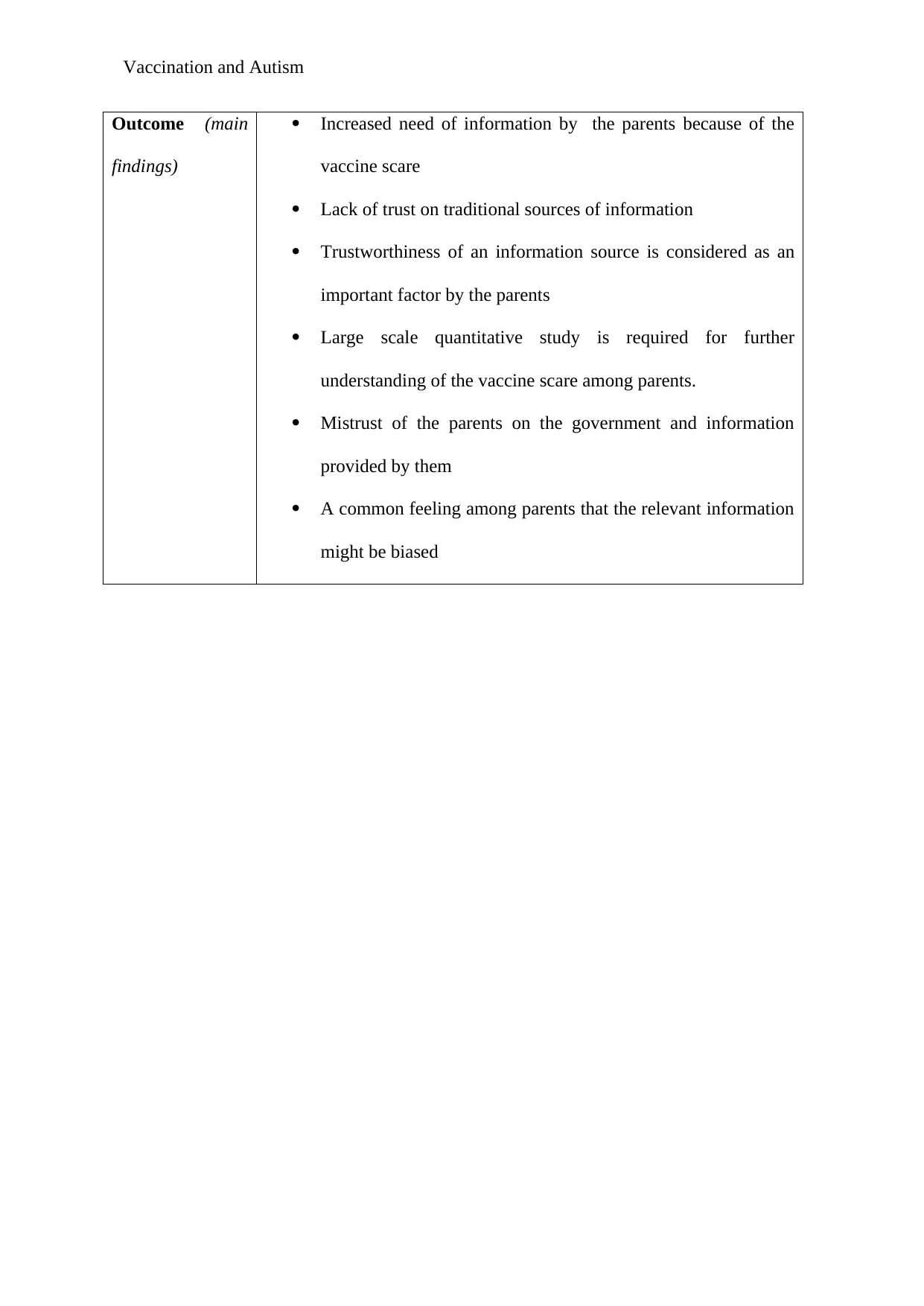
Vaccination and Autism
Outcome (main
findings)
Increased need of information by the parents because of the
vaccine scare
Lack of trust on traditional sources of information
Trustworthiness of an information source is considered as an
important factor by the parents
Large scale quantitative study is required for further
understanding of the vaccine scare among parents.
Mistrust of the parents on the government and information
provided by them
A common feeling among parents that the relevant information
might be biased
Outcome (main
findings)
Increased need of information by the parents because of the
vaccine scare
Lack of trust on traditional sources of information
Trustworthiness of an information source is considered as an
important factor by the parents
Large scale quantitative study is required for further
understanding of the vaccine scare among parents.
Mistrust of the parents on the government and information
provided by them
A common feeling among parents that the relevant information
might be biased
Paraphrase This Document
Need a fresh take? Get an instant paraphrase of this document with our AI Paraphraser
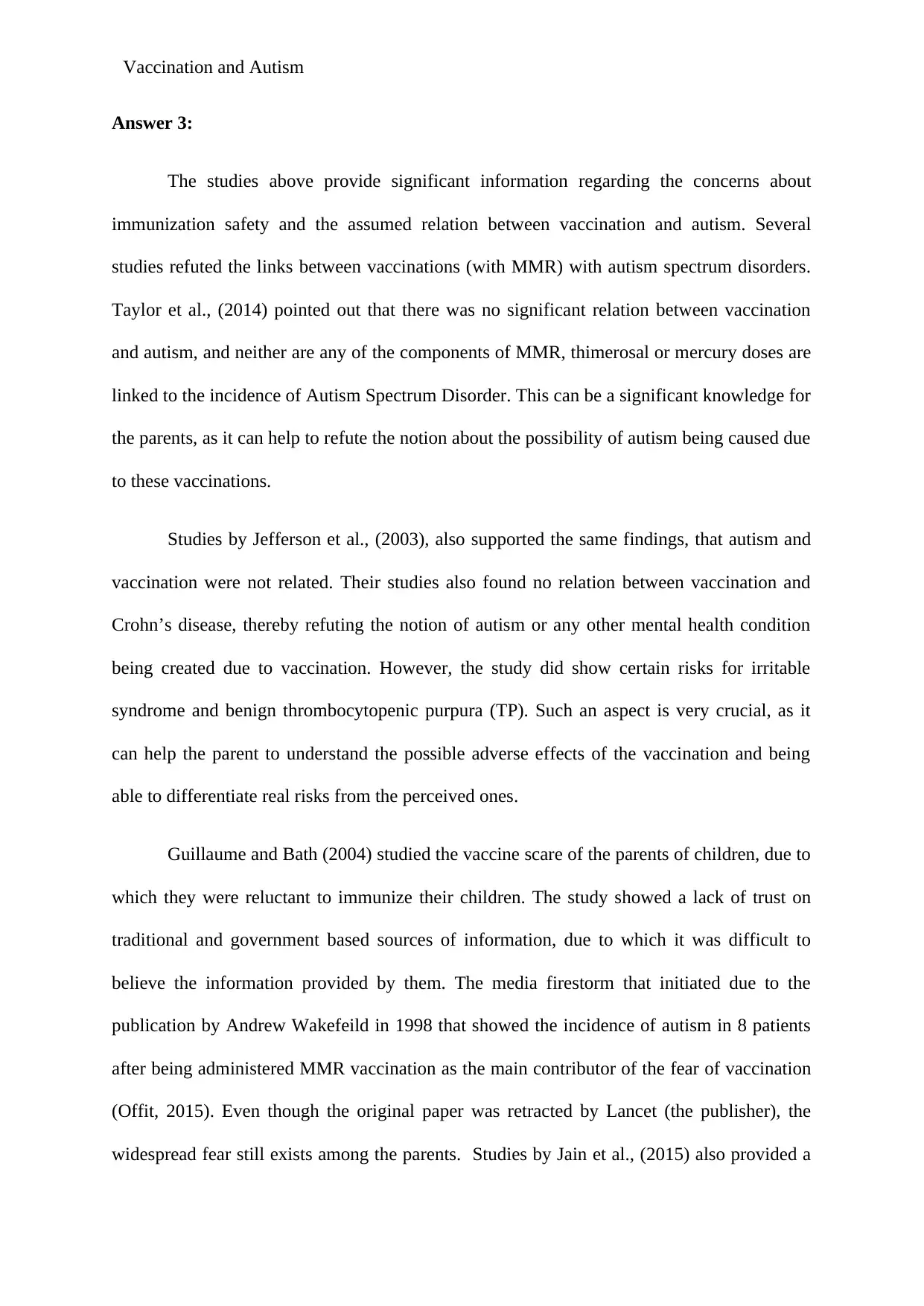
Vaccination and Autism
Answer 3:
The studies above provide significant information regarding the concerns about
immunization safety and the assumed relation between vaccination and autism. Several
studies refuted the links between vaccinations (with MMR) with autism spectrum disorders.
Taylor et al., (2014) pointed out that there was no significant relation between vaccination
and autism, and neither are any of the components of MMR, thimerosal or mercury doses are
linked to the incidence of Autism Spectrum Disorder. This can be a significant knowledge for
the parents, as it can help to refute the notion about the possibility of autism being caused due
to these vaccinations.
Studies by Jefferson et al., (2003), also supported the same findings, that autism and
vaccination were not related. Their studies also found no relation between vaccination and
Crohn’s disease, thereby refuting the notion of autism or any other mental health condition
being created due to vaccination. However, the study did show certain risks for irritable
syndrome and benign thrombocytopenic purpura (TP). Such an aspect is very crucial, as it
can help the parent to understand the possible adverse effects of the vaccination and being
able to differentiate real risks from the perceived ones.
Guillaume and Bath (2004) studied the vaccine scare of the parents of children, due to
which they were reluctant to immunize their children. The study showed a lack of trust on
traditional and government based sources of information, due to which it was difficult to
believe the information provided by them. The media firestorm that initiated due to the
publication by Andrew Wakefeild in 1998 that showed the incidence of autism in 8 patients
after being administered MMR vaccination as the main contributor of the fear of vaccination
(Offit, 2015). Even though the original paper was retracted by Lancet (the publisher), the
widespread fear still exists among the parents. Studies by Jain et al., (2015) also provided a
Answer 3:
The studies above provide significant information regarding the concerns about
immunization safety and the assumed relation between vaccination and autism. Several
studies refuted the links between vaccinations (with MMR) with autism spectrum disorders.
Taylor et al., (2014) pointed out that there was no significant relation between vaccination
and autism, and neither are any of the components of MMR, thimerosal or mercury doses are
linked to the incidence of Autism Spectrum Disorder. This can be a significant knowledge for
the parents, as it can help to refute the notion about the possibility of autism being caused due
to these vaccinations.
Studies by Jefferson et al., (2003), also supported the same findings, that autism and
vaccination were not related. Their studies also found no relation between vaccination and
Crohn’s disease, thereby refuting the notion of autism or any other mental health condition
being created due to vaccination. However, the study did show certain risks for irritable
syndrome and benign thrombocytopenic purpura (TP). Such an aspect is very crucial, as it
can help the parent to understand the possible adverse effects of the vaccination and being
able to differentiate real risks from the perceived ones.
Guillaume and Bath (2004) studied the vaccine scare of the parents of children, due to
which they were reluctant to immunize their children. The study showed a lack of trust on
traditional and government based sources of information, due to which it was difficult to
believe the information provided by them. The media firestorm that initiated due to the
publication by Andrew Wakefeild in 1998 that showed the incidence of autism in 8 patients
after being administered MMR vaccination as the main contributor of the fear of vaccination
(Offit, 2015). Even though the original paper was retracted by Lancet (the publisher), the
widespread fear still exists among the parents. Studies by Jain et al., (2015) also provided a
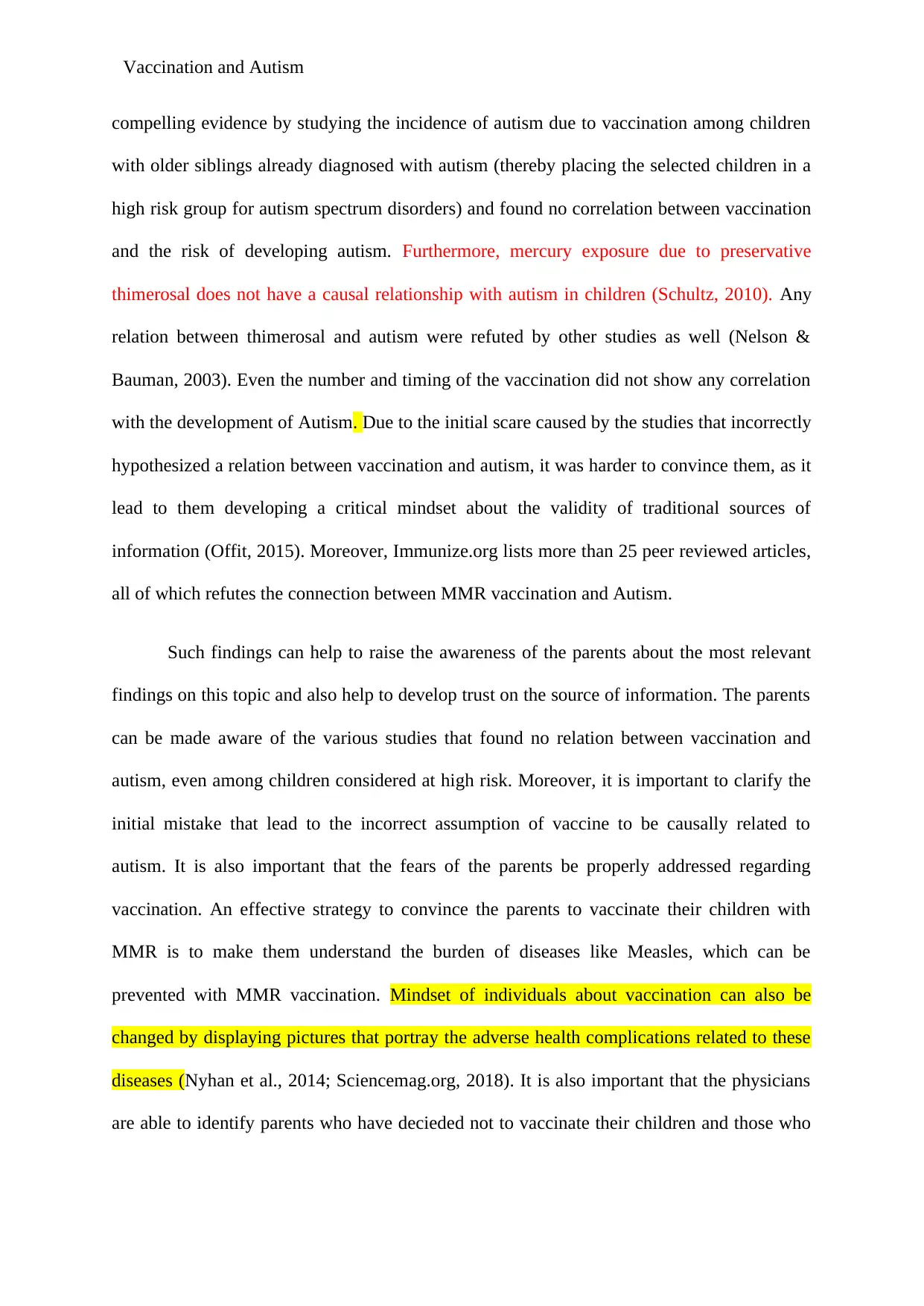
Vaccination and Autism
compelling evidence by studying the incidence of autism due to vaccination among children
with older siblings already diagnosed with autism (thereby placing the selected children in a
high risk group for autism spectrum disorders) and found no correlation between vaccination
and the risk of developing autism. Furthermore, mercury exposure due to preservative
thimerosal does not have a causal relationship with autism in children (Schultz, 2010). Any
relation between thimerosal and autism were refuted by other studies as well (Nelson &
Bauman, 2003). Even the number and timing of the vaccination did not show any correlation
with the development of Autism. Due to the initial scare caused by the studies that incorrectly
hypothesized a relation between vaccination and autism, it was harder to convince them, as it
lead to them developing a critical mindset about the validity of traditional sources of
information (Offit, 2015). Moreover, Immunize.org lists more than 25 peer reviewed articles,
all of which refutes the connection between MMR vaccination and Autism.
Such findings can help to raise the awareness of the parents about the most relevant
findings on this topic and also help to develop trust on the source of information. The parents
can be made aware of the various studies that found no relation between vaccination and
autism, even among children considered at high risk. Moreover, it is important to clarify the
initial mistake that lead to the incorrect assumption of vaccine to be causally related to
autism. It is also important that the fears of the parents be properly addressed regarding
vaccination. An effective strategy to convince the parents to vaccinate their children with
MMR is to make them understand the burden of diseases like Measles, which can be
prevented with MMR vaccination. Mindset of individuals about vaccination can also be
changed by displaying pictures that portray the adverse health complications related to these
diseases (Nyhan et al., 2014; Sciencemag.org, 2018). It is also important that the physicians
are able to identify parents who have decieded not to vaccinate their children and those who
compelling evidence by studying the incidence of autism due to vaccination among children
with older siblings already diagnosed with autism (thereby placing the selected children in a
high risk group for autism spectrum disorders) and found no correlation between vaccination
and the risk of developing autism. Furthermore, mercury exposure due to preservative
thimerosal does not have a causal relationship with autism in children (Schultz, 2010). Any
relation between thimerosal and autism were refuted by other studies as well (Nelson &
Bauman, 2003). Even the number and timing of the vaccination did not show any correlation
with the development of Autism. Due to the initial scare caused by the studies that incorrectly
hypothesized a relation between vaccination and autism, it was harder to convince them, as it
lead to them developing a critical mindset about the validity of traditional sources of
information (Offit, 2015). Moreover, Immunize.org lists more than 25 peer reviewed articles,
all of which refutes the connection between MMR vaccination and Autism.
Such findings can help to raise the awareness of the parents about the most relevant
findings on this topic and also help to develop trust on the source of information. The parents
can be made aware of the various studies that found no relation between vaccination and
autism, even among children considered at high risk. Moreover, it is important to clarify the
initial mistake that lead to the incorrect assumption of vaccine to be causally related to
autism. It is also important that the fears of the parents be properly addressed regarding
vaccination. An effective strategy to convince the parents to vaccinate their children with
MMR is to make them understand the burden of diseases like Measles, which can be
prevented with MMR vaccination. Mindset of individuals about vaccination can also be
changed by displaying pictures that portray the adverse health complications related to these
diseases (Nyhan et al., 2014; Sciencemag.org, 2018). It is also important that the physicians
are able to identify parents who have decieded not to vaccinate their children and those who
⊘ This is a preview!⊘
Do you want full access?
Subscribe today to unlock all pages.

Trusted by 1+ million students worldwide
1 out of 14
Related Documents
Your All-in-One AI-Powered Toolkit for Academic Success.
+13062052269
info@desklib.com
Available 24*7 on WhatsApp / Email
![[object Object]](/_next/static/media/star-bottom.7253800d.svg)
Unlock your academic potential
Copyright © 2020–2025 A2Z Services. All Rights Reserved. Developed and managed by ZUCOL.





